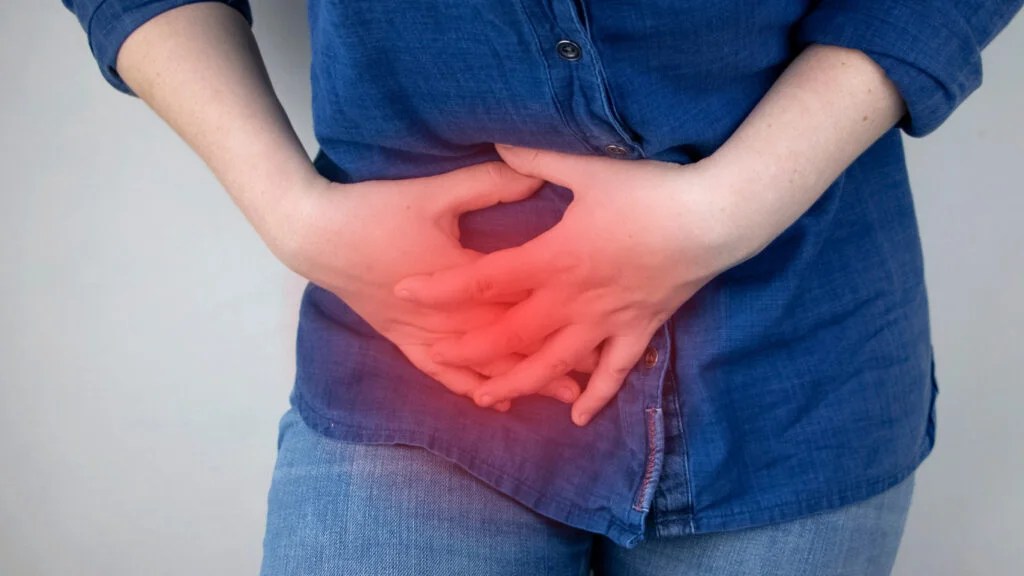- Dr. Rae Osborn
- No Comments
- Medically reviewed by: Muhammad Usman, MD

What is Crohn’s Disease?
Crohn’s disease is a health condition that is categorized as one of the inflammatory bowel diseases (IBDs). It causes your bowels (large and small intestines) to become inflamed and irritated, resulting in severe pain and discomfort.

Crohn’s disease is a lifelong condition. Therefore, to enjoy a normal and limitless life, this article is here to guide you on the best exercise you can do when you are diagnosed with Crohn’s disease.
You are not alone! According to the NIH, it is a relatively common condition, affecting over half a million people in the United States alone.
The effect of this disease can be highly debilitating for those who suffer from it. If you have Crohn’s disease, you may also experience dangerous complications. Complications such as abdominal abscesses, blood clots, and colon cancer are possible, so proper management is critical.
Before we get into the exercises you can do with Crohn’s disease, let’s take a quick look at its diagnosis and symptoms.
Diagnosis and Symptoms of Crohn’s Disease
Diagnosis of Crohn’s Disease:
Only a doctor can provide a confirmatory diagnosis for this condition. To do this, you will be made to go through a series of tests. The most common way to do this is by taking a biopsy of the intestinal wall during a colonoscopy procedure.
Nevertheless, if you think you may have the condition, let’s move to the next section to see the symptoms of Crohn’s disease.
Is It Safe to Exercise When You Have Crohn’s Disease?
You may wonder if exercising is safe if you have Crohn’s disease because of the severity of the symptoms. It is safe to exercise with Crohn’s disease.
Even though it is safe to exercise, not every exercise is ideal. This article is here to guide you, so you don’t make a mistake.
Please note that exercises are only recommended during times when you feel better and not when your symptoms are severe. Read on to learn about the exercises you can do even if you have Crohn’s disease.
It is always important to check with your doctor before beginning any exercise program, so even though we are discussing some options here, you should see your doctor before attempting any change in your exercise routine.
Precautions to Take When Exercising
Here are some precautions you should take when exercising if you have Crohn’s disease.
Drink Lots of Water
This will not only help you avoid dehydration, but it will also help you maintain energy and motivation. Also, staying hydrated is a smart way to avoid fatigue.
Avoid Caffeinated Beverages and Alcoholic Drinks
With Crohn’s disease, caffeine is not advisable. It aggravates the symptoms of the condition, causing diarrhea and discomfort.
Diarrhea Means No Exercise
Any day you have diarrhea, you shouldn’t exercise. This will help you avoid dehydration and quicken your recovery.
Hot Weather
Exercise should be avoided in extremely hot weather. You might get heat exhaustion or heat stroke, which, in addition to making you feel awful, can be fatal.
Fatigue
The moment you notice you are becoming fatigued, you should call it a day during exercise. It doesn’t matter how much time you’ve spent. A little exercise is always better than overdoing it.
Locate a Restroom
Since Crohn’s disease affects your gut, it is best to find a place to exercise where restrooms are available and close, just in case you need to use it.
Don’t Eat Immediately After
Yes! It is best you give yourself about two hours after exercising before eating. This will give your body, especially your gut, just enough time to get balanced.
The Benefits of Exercise for People with Crohn’s Disease
Physical activity benefits everyone. Sometimes, it is even more beneficial to those who are diagnosed with life-long conditions. This is because it improves general health and assists the organs of the body in managing the condition better.
Surveys given to people with Crohn’s disease have indicated that exercise is an essential way to manage the condition.
Benefits of Exercise to People with Crohn’s Disease
It Provides Stress Relief
It is very easy to get stressed with Crohn’s disease. Whenever this happens, be reminded that exercise is one of the most significant ways to rescue. Crohn’s disease symptoms can easily worsen when you are stressed, but exercise will help restore calm and make you feel good.
Exercise also influences the release of endorphins. Endorphins are certain chemicals that are produced in the brain that cause you to feel happy, calm, and motivated. These chemicals are capable of reducing stress and depression.
It Will Boost Your Immune System
A stable and working immune system is expedient for good health. Another advantage of exercising for those with Crohn’s disease is that it helps the immune system to function properly. This is a great advantage because a poor immune system is the father of bad health.
In fact, scientists have found that when muscles contract during physical exercise, they produce some chemicals called myokines. These myokines have an anti-inflammatory effect on your body. Do you still remember that Crohn’s disease is an inflammatory disease? This implies that exercise will help you manage the condition better.
It Prevents Bone Loss
The loss of bone mass is called osteoporosis. It is a major concern for individuals who have Crohn’s disease. It happens mainly because of poor absorption of calcium from food and vitamin D deficiency. Exercise is a great way to strengthen the bones. Also, if you exercise in the morning sun, you will absorb more vitamin D, and it will also help your body to produce more calcium.
Exercises for People with Crohn’s Disease
When it comes to choosing your exercise activity, you should select activities that you like and enjoy. This is because choosing activities that don’t interest you will likely get you bored and tired.
It is also a smart move to select more than one type of exercise to avoid boredom due to monotonicity. If you have not exercised before, it is a good idea to begin slowly and gradually increase how much you do in time if you feel better.
Remember, it is always wise to check with your doctor before any drastic change in your exercise routine.
Why Low-Impact Exercise is Best
Low-impact exercises are best for Crohn’s disease. They provide so many benefits to the body without exposing it to stress. For people with Crohn’s disease, it is best to avoid high-intensity workouts as these may worsen the pain and inflammatory reactions in some people.
Another reason low-impact activities are the best for most people with Crohn’s is that they are not as physically draining as high-impact exercises. They are unlikely to flare up your condition. Rather, they will actually improve your general health and quality of life. The following exercises are recommended for people with Crohn’s disease.
Low-Impact Aerobic Exercises
Aerobic exercises are also called cardio. They are activities that help to condition the cardiovascular system. They increase the heart rate and the body’s use of oxygen.
Exercises under this category will keep your heart and blood vessels healthy. For a better experience, it is advisable that you begin slowly and then increase your pace and duration as you adapt better.
It is crucial that you do not overdo any physical exercise but rather slowly, increasing with time; your body will develop stronger endurance and tolerance. If you are, however, uncertain, feel free to ask your doctor for advice.
Examples of Low-Impact Aerobic Exercises
Low-Impact Aerobic Exercises
This is a good type of exercise, to begin with. You can start slowly and walk around your neighborhood. You can spice things up by walking through a natural reserve. You can increase your pace over time. Walking will keep you healthy, energized, and motivated. Bear in mind that there may not be restrooms in nature reserves.
Swimming
You can join a gym or a swimming club if you do not have access to a swimming pool where you live. Never swim alone, even if you are a good swimmer! Also, check if there are lifeguards on duty before you start swimming. This will make swimming safer for you.
Bike Riding
You can use a stationary bike or a regular bicycle to exercise; a stationary bike is more convenient because it enables you to exercise indoors or during bad weather. However, the disadvantage of a stationary bike is that you may quickly get bored. To avoid this, you can get a regular bicycle and ride in clear and cool weather.
Water Aerobics
Water aerobics is great for Crohn’s disease. The easiest way to learn how to do these types of exercises is to join a water aerobics class. Amongst other things, it can also be a fun way to socialize and help reduce stress.
Resistance Exercises
Resistance exercises are those activities that help to increase muscle and bone strength. Joining a gym is usually the best strategy for people who don’t own the right exercise equipment. A trainer can give you further advice on how to exercise safely.
Always remember not to overdo any exercise.
Examples of Resistance Exercises for People with Crohn’s Disease
Pulling Elastic Bands
This is an excellent way to increase your level of resistance. It involves you pulling elastic bands apart. This particular exercise can exercise many muscles of the body at a time.
Lifting Weights
This does not only help to build muscle, but it also helps reduce inflammation in the body.
Squats
Squats work the gluteal muscles and hamstrings at the back of your leg.
Push-Ups
This is a good way to increase the strength of your upper body, including your chest muscles, shoulders, and arms.
Back Extensions
These exercises are a great way to improve your posture while strengthening your back muscles at the same time.
Abdominal Crunches
The abdominal area muscles, including the obliques and rectus abdominis muscles, are strengthened with abdominal crunches.
Meditative Exercises
Stress is the number one drainer of energy. It has a negative effect on the body and is often related to flare-ups of symptoms in people with Crohn’s disease.
Meditative exercises will help you relax and stay motivated in life. This is why choosing meditative exercises may be very useful and beneficial. Examples of meditative exercises for Crohn’s disease are:
Tai Chi
This is frequently regarded as a good exercise for people of all fitness levels; it entails specific movements and deep breathing.
Yoga
Yoga is one of the most beneficial meditative exercises for people with Crohn’s disease. It will relax the body and train the mind to manage the pain better.
Some Beneficial Physical Activities That Are Not Really Exercises
Even if you do not wish to begin a specific type of exercise, there are some activities that can help you become more active. Gardening, housework, and dancing are a few examples. Gardening is a fun hobby that gets you outside while also working on your muscles. These simple everyday activities can be combined with the types of exercises mentioned above for better health.
The Importance of Sleep Along With Exercise
Good quality sleep is as essential as exercising for those living with Crohn’s disease. Sleep enhances brain performance, mood, and overall health. Not getting enough quality sleep on a regular basis increases the risk of a variety of diseases and disorders.
Getting enough sleep is critical for people with Crohn’s disease because it relaxes the body and reduces stress. It is especially important to get enough rest if you are experiencing a flare-up and are not feeling well. Remember to include sleep and regular exercise as part of your Crohn’s disease management strategy.
Medical and Dietary Treatment for Crohn’s Disease
In addition to the exercises mentioned above, you should also try your best to follow the medical advice of your doctor. Here are some important dietary and medical tips worth knowing:
Immune System Regulating Medicines
The mainstay of treatment now is the use of immunomodulators and biologics. Steroids are only used as rescue therapy. Seek the advice of your doctor before taking any drug that has an effect on your immune system.
Bowel Control Medicines
Anti-diarrheal and anti-spasmodic medicine are sometimes required to help the intestines when you experience diarrhea and cramps.
Antimicrobials
Bacterial infections can worsen the symptoms of Chron’s disease. There may be a need to take antibiotics when there are indications of an infection.
Surgery
Diet Changes
Changes in what you eat may be necessary when they begin to worsen your symptoms. What changes you make may vary depending on the nature of your Crohn’s disease. Check with your doctor for more information on diet suggestions.
Conclusion
After consulting with their doctor, people with Crohn’s disease can exercise when they feel well enough. Low-impact aerobic, resistance, and meditative exercises are the most beneficial. Remember that getting enough sleep is just as important as exercising.
References

DR. RAE OSBORN
Dr. Rae Osborn was educated in South Africa and the United States. She holds Honors Bachelor of Science degrees in Zoology and Entomology, and Masters of Science in Entomology from the University of Natal in South Africa. She has received a PhD in Quantitative Biology from the University of Texas at Arlington as well as an AAS Degree in Information Network Specialist and an AAS in Computer Information Systems from Bossier Parish Community College in Louisiana.
She was a tenured Associate Professor of Biology in the United States. She has published in peer-reviewed journals and has taught college-level courses. Currently she works as a freelance writer and editor in the areas of medicine, health, biology, and computer science.

DR. RAE OSBORN
Dr. Rae Osborn was educated in South Africa and the United States. She holds Honors Bachelor of Science degrees in Zoology and Entomology, and Masters of Science in Entomology from the University of Natal in South Africa. She has received a PhD in Quantitative Biology from the University of Texas at Arlington as well as an AAS Degree in Information Network Specialist and an AAS in Computer Information Systems from Bossier Parish Community College in Louisiana.
She was a tenured Associate Professor of Biology in the United States. She has published in peer-reviewed journals and has taught college-level courses. Currently she works as a freelance writer and editor in the areas of medicine, health, biology, and computer science.
